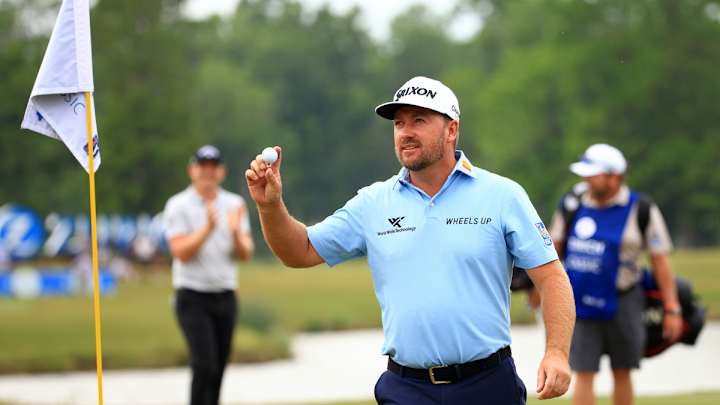Hole-in-one stands out as little more than stroke of luck

The hole-in-one is golf’s equivalent to snagging a 10-point buck or reeling in a 400-pound bluefin tuna. Such rare occurrences represent life at its finest, creating memories never to be forgotten, although killing a deer or catching a massive fish requires a certain amount of skill, patience and preparation. Holing a 9-iron from the 14th tee at your local municipal requires luck. Just dumb, bald-faced, beautiful luck.
It is the ultimate stroke of good fortune, a heart-pounding, hand-quivering experience that can evoke more volcanic joy from the rest of the foursome than the player who struck the shot. Everybody at the club hears about the ace long before the round is finished. It often means a free drink for all those in the lounge afterward, courtesy of the man of the hour, which is why some private establishments add a couple of bucks onto your monthly bill for hole-in-one insurance.
Few things brighten up the room more vividly than a 1 on the scorecard, which in itself should serve as sufficient cause to consider them vastly overrated. Did the guy who made the ace break 90? My first hole-in-one occurred in 1997 while on an assignment in England, where I basically sat around for a week waiting to interview Colin Montgomerie. A pitching wedge from 124 yards on the second hole of a course whose name I’ve long forgotten, an uphill shot into an undulated green, meaning I couldn’t tell if the ball actually went in.
It had, and for the next 15 minutes, I couldn’t remember how to swing a golf club. My 6-1-6 start sounds more like a Midwestern area code than any way to begin a round. Still, I had my first brush with perfection. Then Monty missed the cut. A trip with lasting purpose.
Five aces later, my jaded philosophy regarding the matter is in no way an attempt to project superiority or violate the sportswriter’s oath to cynicism. Hardly, in fact, given the curious case of my podcast partner and Morning Read colleague Mike Purkey. He has played the game far longer than I, and without question, he is the better player among us. A scratch golfer at one point, Purk owns but a single hole-in-one to show for all those years of double-checking yardage and cussing at himself.
It doesn’t seem fair because it isn’t. Robert Allenby and Hal Sutton share the PGA Tour record for most aces in competition, each with 10. Tiger Woods has two. Willie Wood, for crying out loud, has seven. A lot of tour pros whom you don’t remember (or never heard of) boast three or more, whereas Ben Hogan, Mr. Precision himself, retired with just one, at the 1947 Esmeralda Open. Arnold Palmer and Jack Nicklaus finished tied with three, leading one to believe that if either man knew that, they would have gone back out to settle the score before it was too late.
When Graeme McDowell holed out from the tee on the 216-yard 17th during the second round in New Orleans two weeks ago, you’d have thought that Golf Channel might demand a stoppage of play to host a ticker-tape parade. Yes, it was a weak field, and of course, nobody ever won a Tour event on a Friday, but a solid 10 minutes of airtime was devoted to the shot, which analyst Frank Nobilo referred to as one of the great moments of McDowell’s career.
Wow! Really? The Northern Irishman won the 2010 U.S. Open and carried Europe to victory in the Ryder Cup that same year. He has collected 14 big-league victories and got to as high as fourth in the Official World Golf Ranking. Even if someone did spike the punch in the broadcast booth that afternoon, Nobilo’s assessment was a gross overstatement poorly disguised as a loss of perspective.
Of course, that’s golf on TV these days. If you don’t have something really nice to say, don’t even think about saying it. Holes-in-one are fabulous and all, but their long-term value is fleeting, their nutritional value equal to that of a bag of M&Ms.
The greatest hole-in-one in Tour history has to be owned by Jonathan Byrd, who jarred a 6-iron on the fourth extra hole to end a three-man playoff in Las Vegas 11 years ago. To make an ace as the game-winner, especially in overtime, is a feat actually worthy of all the commotion that has ensued following the millions of other HIOs over the years, regardless of whether it was the handiwork of a 16-handicap or a multiple-major champion.
Here’s the punchline: Byrd’s ace in Vegas, which remains the only one ever in a playoff, is not listed in the PGA Tour media guide with the other four he has collected since 2006. So much for clerical accuracy. Maybe Palmer and Nicklaus don’t have to break that tie, after all. What is also notable about Byrd’s historic swing is that it was almost pitch-dark when he made it. So dark that he was unable to pick up the ball’s flight as it soared toward the green, much less see it land 10 feet short of the pin, then magically reappear as a $774,000 winner’s check.
Some guys have all the luck. The highly unusual, bombastically celebrated act known as the hole-in-one is nothing more or less than a gift from the golf gods. A lottery ticket dressed up as a little white ball with dimples, a random encounter with brilliance, during which fate turns a very good shot into an unforgettable one. An inch here, an inch there, and you’re looking at tap-in birdie.
That’s fine, but it’s not forever. As Byrd proved, the ultimate stroke of good fortune can happen anytime and anywhere, even long after sundown, at which point you don’t have to see it to believe it. Nobody ever killed a deer with his eyes closed.
Sign up to receive the Morning Read newsletter, along with Where To Golf Next and The Equipment Insider.
